【CentOS】有关时间的设置
目录
- 环境信息
- date
- 语法信息
- 查看时间
- 设置时间
- 设置日期
- tzselect
- timedatectl
- 语法
- 显示当前及所有时区
- 修改时区
- hwclock
- 语法
- 读取硬件时钟
- 使用硬件时钟设置系统时间
- 使用系统时间设置硬件时钟
- 如何理解硬件时钟和系统时钟
环境信息
- CentOS 7
date
语法信息
date --help
用法:date [选项]... [+格式]或:date [-u|--utc|--universal] [MMDDhhmm[[CC]YY][.ss]]
Display the current time in the given FORMAT, or set the system date.Mandatory arguments to long options are mandatory for short options too.-d, --date=STRING display time described by STRING, not 'now'-f, --file=DATEFILE like --date once for each line of DATEFILE-I[TIMESPEC], --iso-8601[=TIMESPEC] output date/time in ISO 8601 format.TIMESPEC='date' for date only (the default),'hours', 'minutes', 'seconds', or 'ns' for dateand time to the indicated precision.-r, --reference=文件 显示文件指定文件的最后修改时间-R, --rfc-2822 以RFC 2822格式输出日期和时间例如:2006年8月7日,星期一 12:34:56 -0600--rfc-3339=TIMESPEC output date and time in RFC 3339 format.TIMESPEC='date', 'seconds', or 'ns' fordate and time to the indicated precision.Date and time components are separated bya single space: 2006-08-07 12:34:56-06:00-s, --set=STRING set time described by STRING-u, --utc, --universal print or set Coordinated Universal Time (UTC)--help 显示此帮助信息并退出--version 显示版本信息并退出给定的格式FORMAT 控制着输出,解释序列如下:%% 一个文字的 %%a 当前locale 的星期名缩写(例如: 日,代表星期日)%A 当前locale 的星期名全称 (如:星期日)%b 当前locale 的月名缩写 (如:一,代表一月)%B 当前locale 的月名全称 (如:一月)%c 当前locale 的日期和时间 (如:2005年3月3日 星期四 23:05:25)%C 世纪;比如 %Y,通常为省略当前年份的后两位数字(例如:20)%d 按月计的日期(例如:01)%D 按月计的日期;等于%m/%d/%y%e 按月计的日期,添加空格,等于%_d%F 完整日期格式,等价于 %Y-%m-%d%g ISO-8601 格式年份的最后两位 (参见%G)%G ISO-8601 格式年份 (参见%V),一般只和 %V 结合使用%h 等于%b%H 小时(00-23)%I 小时(00-12)%j 按年计的日期(001-366)%k hour, space padded ( 0..23); same as %_H%l hour, space padded ( 1..12); same as %_I%m month (01..12)%M minute (00..59)%n 换行%N 纳秒(000000000-999999999)%p 当前locale 下的"上午"或者"下午",未知时输出为空%P 与%p 类似,但是输出小写字母%r 当前locale 下的 12 小时时钟时间 (如:11:11:04 下午)%R 24 小时时间的时和分,等价于 %H:%M%s 自UTC 时间 1970-01-01 00:00:00 以来所经过的秒数%S 秒(00-60)%t 输出制表符 Tab%T 时间,等于%H:%M:%S%u 星期,1 代表星期一%U 一年中的第几周,以周日为每星期第一天(00-53)%V ISO-8601 格式规范下的一年中第几周,以周一为每星期第一天(01-53)%w 一星期中的第几日(0-6),0 代表周一%W 一年中的第几周,以周一为每星期第一天(00-53)%x 当前locale 下的日期描述 (如:12/31/99)%X 当前locale 下的时间描述 (如:23:13:48)%y 年份最后两位数位 (00-99)%Y 年份%z +hhmm 数字时区(例如,-0400)%:z +hh:mm 数字时区(例如,-04:00)%::z +hh:mm:ss 数字时区(例如,-04:00:00)%:::z 数字时区带有必要的精度 (例如,-04,+05:30)%Z 按字母表排序的时区缩写 (例如,EDT)默认情况下,日期的数字区域以0 填充。
The following optional flags may follow '%':- (hyphen) do not pad the field_ (underscore) pad with spaces0 (zero) pad with zeros^ use upper case if possible# use opposite case if possible在任何标记之后还允许一个可选的域宽度指定,它是一个十进制数字。
作为一个可选的修饰声明,它可以是E,在可能的情况下使用本地环境关联的
表示方式;或者是O,在可能的情况下使用本地环境关联的数字符号。Examples:
Convert seconds since the epoch (1970-01-01 UTC) to a date$ date --date='@2147483647'Show the time on the west coast of the US (use tzselect(1) to find TZ)$ TZ='America/Los_Angeles' dateShow the local time for 9AM next Friday on the west coast of the US$ date --date='TZ="America/Los_Angeles" 09:00 next Fri'GNU coreutils online help: <http://www.gnu.org/software/coreutils/>
请向<http://translationproject.org/team/zh_CN.html> 报告date 的翻译错误
要获取完整文档,请运行:info coreutils 'date invocation'
查看时间
date
#以RFC 2822格式输出日期和时间 例如:2006年8月7日,星期一 12:34:56 -0600
date -R
#自定义格式显示
date +"%Y-%m-%d"

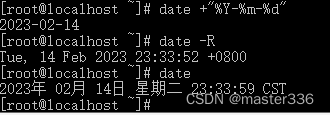
设置时间
不带日期时不会修改日期
#date -s
date -s 22:01:01

设置日期
不带时间时会设置时间为00:00:00
#date -s
date -s 2023-03-15
date -s 20230215
date -s "2023-02-14 23:31:01"
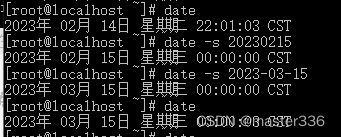

tzselect
交互式设置时区
tzselect
特别注意红色部分
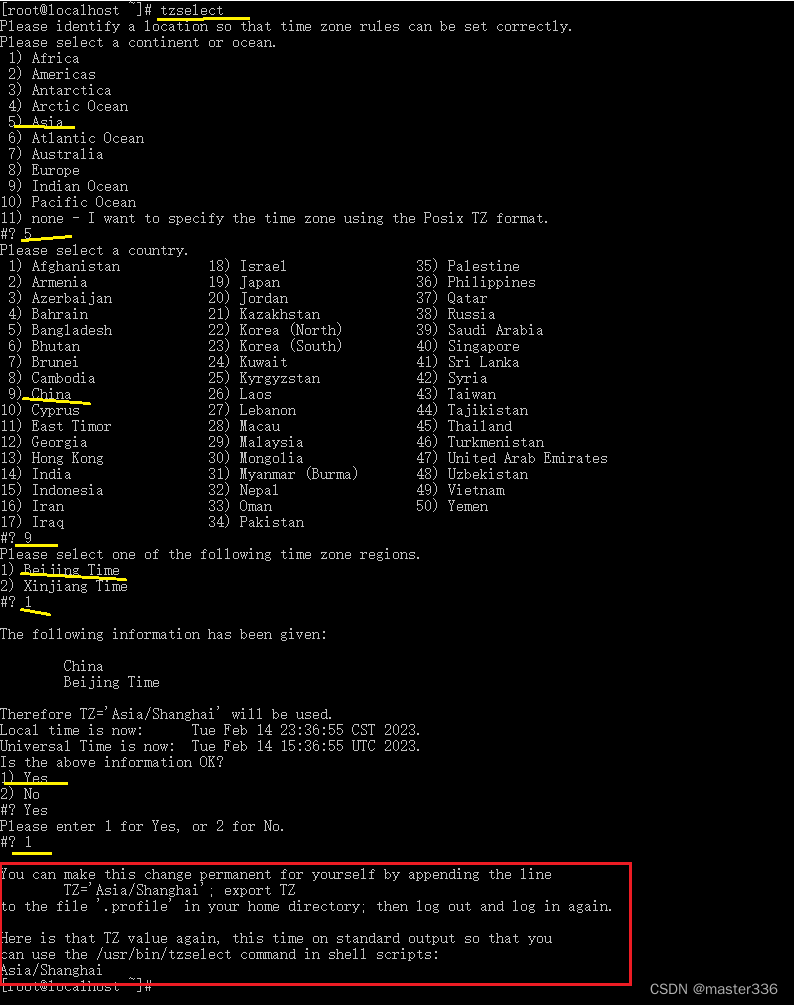
以上修改并不会立即生效,需按照红色要求将TZ设置到环境变量中并重新登录
#以下内容添加到环境变量中,如 /etc/profile、~/.bash_profile等文件
TZ='Asia/Shanghai';
export TZ
timedatectl
语法
timedatectl --help
timedatectl [OPTIONS...] COMMAND ...Query or change system time and date settings.-h --help Show this help message--version Show package version--no-pager Do not pipe output into a pager--no-ask-password Do not prompt for password-H --host=[USER@]HOST Operate on remote host-M --machine=CONTAINER Operate on local container--adjust-system-clock Adjust system clock when changing local RTC modeCommands:status Show current time settingsset-time TIME Set system timeset-timezone ZONE Set system time zonelist-timezones Show known time zonesset-local-rtc BOOL Control whether RTC is in local timeset-ntp BOOL Control whether NTP is enabled
显示当前及所有时区
timedatectl
#等同于
timedatectl status
#显示所有时区timedatectl list-timezones
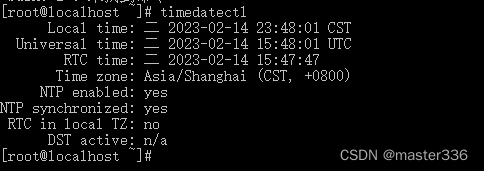
修改时区
timedatectl set-timezone America/New_York
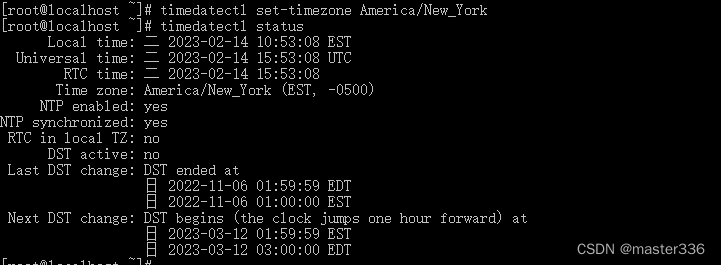
hwclock
语法
hwclock -h
用法:hwclock [功能] [选项...]功能:-h, --help 显示此帮助并退出-r, --show 读取硬件时钟并打印结果--set 将 RTC 设置为 --date 指定的时间-s, --hctosys 从硬件时钟设置系统时间-w, --systohc 从当前系统时间设置硬件时钟--systz 基于当前时区设置系统时间--adjust 根据自上次时钟设置或调整后的系统漂移来调整 RTC-c, --compare 定期将系统时钟与 CMOS 时钟相比较--getepoch 打印内核的硬件时钟纪元(epoch)值--setepoch 将内核的硬件时钟纪元(epoch)值设置为--epoch 选项指定的值--predict 预测 --date 选项所指定时刻读取到的 RTC 值-V, --version 显示版本信息并退出选项:-u, --utc 硬件时钟保持为 UTC 时间--localtime 硬件时钟保持为本地时间-f, --rtc <文件> 代替默认文件的特殊 /dev/... 文件--directisa 直接访问 ISA 总线,而非 /dev/rtc--badyear 忽略 RTC 年份(由于 BIOS 损坏)--date <时间> 指定要设置的硬件时钟时间--epoch <年> 指定作为硬件纪元(epoch)值起始的年份--noadjfile 不访问 /etc/adjtime;需要使用 --utc 或 --localtime 选项--adjfile <文件> 指定调整文件的路径;默认为 /etc/adjtime--test 不更新,只显示将进行什么操作-D, --debug 调试模式
读取硬件时钟
hwclock -r

使用硬件时钟设置系统时间
hwclock -s

使用系统时间设置硬件时钟
hwclock -w
如何理解硬件时钟和系统时钟
操作系统有两个时钟,分别是硬件时钟和系统时钟,大多数操作系统的时钟管理方式如下:
硬件时钟: 是指主机板上的时钟设备,也就是通常可在BIOS画面设定的时钟。
系统时钟: 则是指kernel中的时钟。
- 启动时根据硬件时钟设置系统时钟
- 关机时根据系统时钟设置硬件时钟
